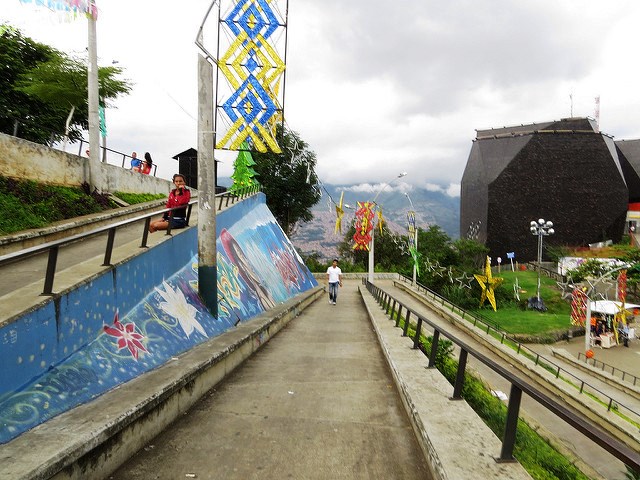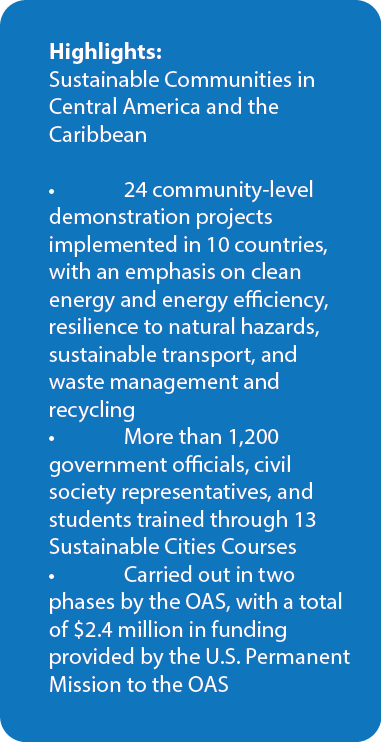
ECPA IN ACTION
 More than four out of five people in Latin America and the Caribbean now live in cities. This creates major challenges—more pollution, snarled traffic, decaying infrastructure, rising energy demands, and greater vulnerability to natural disasters, to name just a few—and is prompting local government officials to take the lead on sustainability. In the last several years, the Organization of American States (OAS) has supported such efforts, under the umbrella of the Energy and Climate Partnership of the Americas (ECPA), through an initiative called Sustainable Communities in Central America and the Caribbean.
More than four out of five people in Latin America and the Caribbean now live in cities. This creates major challenges—more pollution, snarled traffic, decaying infrastructure, rising energy demands, and greater vulnerability to natural disasters, to name just a few—and is prompting local government officials to take the lead on sustainability. In the last several years, the Organization of American States (OAS) has supported such efforts, under the umbrella of the Energy and Climate Partnership of the Americas (ECPA), through an initiative called Sustainable Communities in Central America and the Caribbean.For cities across the region, the task of becoming more sustainable could not be more urgent. A 2015 study by the Inter-American Development Bank—The Experience of Latin America and the Caribbean in Urbanization—noted that this region has one of the highest urban growth rates in the world, with more than 80 percent of the population currently living in cities. That figure is expected to reach 90 percent in 25 years, the study said.
 Mayors and other local and state officials on the front lines are increasingly aware that they need to find sustainable solutions to urban problems. Citizens are also stepping up the pressure to make their cities more livable and sustainable.
Mayors and other local and state officials on the front lines are increasingly aware that they need to find sustainable solutions to urban problems. Citizens are also stepping up the pressure to make their cities more livable and sustainable.
In other words, quite aside from what happens on a national or international level, towns and cities are going green, said Richard Huber, Chief of the OAS Sustainable Communities, Hazard Risk, and Climate Change Section.
“The action is really happening at the local level,” Huber said in an interview. “Federal and national governments are moving ahead with global climate agreements, but it is the mayors and governors who are making the sustainability agenda a reality by converting their cities into low-carbon economies.”
One way the OAS has promoted sustainability at the local level has been through a technical assistance and small-grants initiative called Sustainable Communities in Central America and the Caribbean, funded primarily by the Permanent Mission of the United States to the OAS. The initiative, which was launched in late 2012 and has just completed its second phase, has awarded grants of up to $50,000 to support demonstration projects at the community level.
As part of the initiative, the OAS has also held intensive, four- to six-day Sustainable Cities Courses around the region, geared toward government officials, civil society representatives, and university students. The first such course was held in Medellín, Colombia, in December 2013, and 12 other editions have since been offered in cities across Latin America and the Caribbean—most recently in Miraflores, Peru, and Basseterre, Saint Kitts and Nevis. (See related stories in this issue.)
No two courses have been exactly alike, Huber said, because each has been tailor-made to its location, with input and active participation from local partners, including universities, municipal governments, and state and federal agencies. Courses are taught by local experts, who are encouraged to delve into local problems, and breakout sessions allow for interaction across disciplines.
The courses, which provide 40 hours of training, are structured around modules that cover such topics as urban planning, sustainable transport, waste management, resilience to natural hazards, built environments, and renewable energy in the context of sustainable cities. An online version of the course is in the process of being developed.
In the years since he’s been running the project, Huber has seen growing interest—even friendly competition—among mayors throughout the region to make their cities more sustainable. After all, he said, going green brings tangible benefits: it can save money, reduce air pollution, cut energy bills, and make constituents happier besides. “What’s not to like?” he asked.
 View Map
View Map